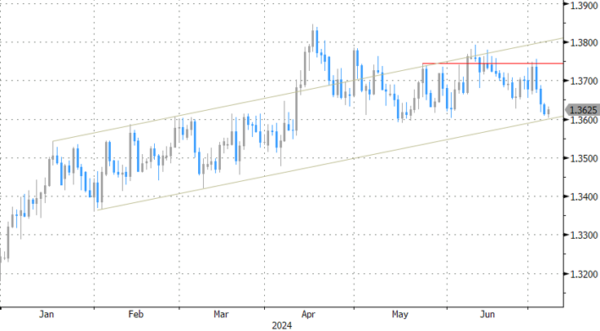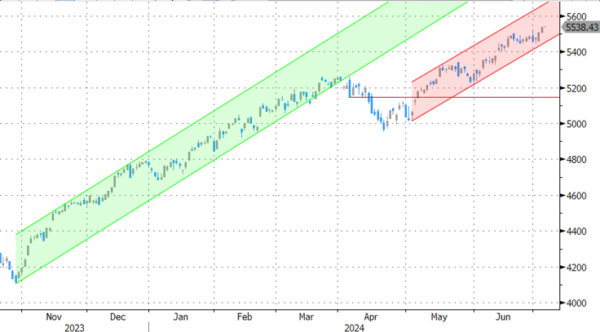Markets
Payrolls have arrived. Net job creation in the US amounted to 206k in June. While slightly topping the 190k estimate, it came with a significant downward revision for the previous two months (-111k). In addition, about a third of June’s jobs came on the account of the government (+70k). That same government was also largely responsible for the JOLTS uptick published earlier this week (May). Other sectors adding jobs were health & social assistance (+82k) and wholesale trade (+14k). Retail trade (-9k), professional business services (-17k) and manufacturing (-8k) shed some. Hourly earnings came in at the expected 0.3% m/m (3.9% y/y). The unemployment rate unexpectedly ticking higher to 4.1% – the highest since November 2021 – draws attention after several Fed governors recently expressed growing concerns the labour market may be nearing an inflection point. The participation rate creeped marginally higher to 62.6%. All in all not an outright weak report but one that does show the labour market is slowing further. It’s too soon for the June edition to cement a September rate cut – market odds remain +/- 80% – but it obviously doesn’t call one into question either. US yields added to their previous losses in the wake of the report, especially at the front. Net daily changed vary between -2 bps (30-yr) to -7 bps (2-yr). The mid-June support zone around 4.65% in the 2-yr yield risks giving way. German yield declines range between -1.7 and -3.2 bps. The dollar retains the losses incurred earlier on the day. EUR/USD changes hands around 1.083, up from 1.0812. A minor drop in USD/JPY (to 160.82) does little to reassure Japanese officials. Next week is another important one for the US with June CPIs due and Fed chair Powell’s semiannual testimony before Congress. We do think he’ll save the juicy quotes for a potentially pivotal Jackson Hole symposium, planned at August 24-26. The Fed by then will have another batch of monthly data at its disposal. Crucially, it’ll be possible to make a first guestimate for the potential April 2023 – March 2024 payrolls revision two days in the run-up. A (sharp) downward adjustment (= the “unexpected labour market weakening” the Fed is wary about?!) is widely anticipated. Sterling is enjoying a nice run against the euro (EUR/GBP 0.845) and the dollar (GBP/USD +1.28) in the wake of a landslide Labour victory. Party leader Starmer held a first speech meanwhile, promising a government of “stability and moderation”. He’ll appoint his cabinet later today. The election topic remains hot with this weekend’s second round in the France due (parliament).
News & Views
The UN Food and Agricultural Organization monthly food price index was unchanged in June. Increases in vegetable oil, sugar and dairy products balanced out a decrease in cereals. The meat index was almost unchanged. Despite rebounding from the lowest level in about 2-year since February, the index remains 2.1% lower Y/Y and 24.8% below the peak of March 2022. Cereal prices declined 3.0% M/M and 9.0%% Y/Y. Global export prices of all major cereals decreased month on month. Improved production prospects in some major exporting countries along with the implementation of a temporary import ban by Turkey contributed to the softer price for wheat. Maize prices also dropped as production in Argentina and Brazil is seen larger than anticipated. Vegetable oil prices rose 3.1% M/M to the highest level since March 2023 due to higher quotations for palm, soy and sunflower oil. The dairy price index rose 1.2% M/M to be 6.6% higher compared to the same month last year.
Hungarian statistical office (KSH) data today suggest lackluster economic momentum. Industrial production dropped 1.1% M/M in May and was 4.9% lower Y/Y. KSH mentions a fall in the manufacture of transport equipment, electrical equipment, as well as in the manufacture of computer, electronic and optical products. Production of food products, beverages and tobacco products increased. In a separate release May retail sales were reported 3.6% higher Y/Y (was 3.2% in April). Food sales rose by 6.3% Y/Y, non-food retailing added 1.8% Y/Y while automotive fuel sales declined 0.7%. KSH assesses sales volumes to have been essentially unchanged from the previous month. Cumulative sales for the first 5 months of 2024 were 2.7% higher compared to last year. After coming under pressure due to global/European related uncertainty (European and French elections), the forint this week captured a better bid, strengthening to EUR/HUF 392.5 currently to be compared with levels near EUR/HUF 398 mid-June.
Graphs
US 2-yr yield mid-June support about to break in the wake of further slowdown in the labour market

GBP/USD: cable nears the upper band of a sideways trading range on combo of sterling strength and dollar weakness

USD/CAD: unexpected decline in Canadian employment offers USD/CAD some relief

S&P500 opens near record high as softening labour market keeps September rate cut on the table










